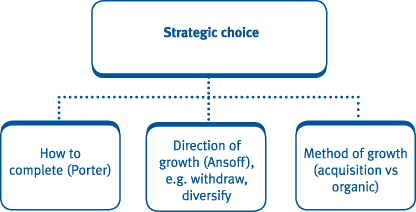Strategic choice
Strategic choice is a key step within the strategic planning process:

Strategic choice
Strategic choice typically follows strategic analysis and is based upon the following three elements.
- Generation of strategic options, e.g. growth, acquisition, diversification or concentration.
- Evaluation of the options to assess their relative merits and feasibility.
- Selection of the strategy or option that the organisation will pursue. There could be more than one strategy chosen but there is a chance of an inherent danger or disadvantage to any choice made. Although there are techniques for evaluating specific options, the selection is often subjective and likely to be influenced by the values of managers and other groups with an interest in the organisation.
In addition to deciding the scope and direction of an organisation,choices also need to be made about how to achieve the goal.
Broadly,there are two ways in which a strategy can be pursued:
- internal development (organic growth)
- external development - merger/acquisition, JV, franchising/licensing.
Generation of strategic options
Three key questions
Strategic options generation is the process of establishing a choice of possible future strategies. There are three main areas to consider.

Porter describes certain generic competitive strategies (lowest cost or differentiation) that an organisation may pursue for competitive advantage They determine how you compete. Porter's model is discussed in more detail here.
Ansoff describes product-market strategies (which markets you should enter or leave). They determine where you compete and the direction of growth. Ansoff's model is discussed in more detail here.
When considering the method of growth the choice may be between models involving 100% ownership (acquisition v organic growth) or a joint strategy (e.g. franchising, joint ventures, etc). These are discussed in more detail here.
Portfolio models
A number of portfolio models (e.g. the BCG matrix) have been developed that attempt to both analyse a product portfolio and generate strategies for those products. These are discussed in more detail here.
Evaluation of the options
Johnson, Scholes and Whittington argue that for a strategy to be successful it must satisfy three criteria:
- Suitability - whether the options are adequate responses to the firm's assessment of its strategic position.
- Acceptability - considers whether the options meet and are consistent with the firm's objectives and are acceptable to the stakeholders.
- Feasibility - assesses whether the organisation has the resources it needs to carry out the strategy.
This criteria can be applied to any strategy decision such as the competitive strategies, the growth strategies, or even the methods of development.
Suitability
Suitability is a useful criterion for screening strategies, asking the following questions about strategic options:
- Does the strategy exploit the company strengths, such as providing work for skilled craftsmen or environmental opportunities, e.g. helping to establish the organisation in new growth sectors of the market?
- How far does the strategy overcome the difficulties identified in the analysis? For example, is the strategy likely to improve the organisation's competitive standing, solve the company's liquidity problems or decrease dependence on a particular supplier?
- Does the option fit in with the organisation's purposes? For example, would the strategy achieve profit targets or growth expectations, or would it retain control for an owner-manager?
Acceptability
Acceptability is essentially about assessing risk and return and is strongly related to stakeholders' expectations. The issue of 'acceptable to whom?' thus requires the analysis to be thought through carefully.
Some of the questions that will help identify the likely consequences of any strategy are as follows:
- How will the strategy impact shareholder wealth? Assessing this could involve calculations relating to NPV, SVA or EVA.
- How will the organisation perform in profitability terms? The parallel in the public sector would be cost/benefit assessment.
- How will the financial risk (e.g. liquidity) change?
- What effect will it have on capital structure (gearing or share ownership)?
- Will the function of any department, group or individual change significantly?
- Will the organisation's relationship with outside stakeholders, e.g. suppliers, government, unions, customers need to change?
- Will the strategy be acceptable in the organisation's environment, e.g. higher levels of noise?
Feasibility
Assesses whether the organisation has the resources it needs to carry out the strategy.
Factors that should be considered can be summarised under the M-word model.
- Machinery. What demands will the strategy make on production? Do we have sufficient spare capacity? Do we need new production systems to give lower cost/better quality/more flexibility/etc?
- Management. Is existing management sufficiently skilled to carry out the strategy.
- Money. How much finance is needed and when? Can we raise this? Is the cash flow feasible?
- Manpower. What demands will the strategy make on human resources? How many employees are needed, what skills will they need and when do we need them? Do we already have the right people or is there a gap? Can the gap be filled by recruitment, retraining, etc?
- Markets. Is our existing brand name strong enough for the strategy to work? Will new brand names have to be established? What market share is needed for success - how quickly can this be achieved?
- Materials. What demands will the strategy make on our relationships with suppliers. Are changes in quality needed?
- Make-up. Is the existing organisational structure adequate or will it need to be changed?
 |
 |
 |
|
Created at 10/11/2012 3:45 PM by System Account
(GMT) Greenwich Mean Time : Dublin, Edinburgh, Lisbon, London
|
Last modified at 9/11/2013 11:59 AM by System Account
(GMT) Greenwich Mean Time : Dublin, Edinburgh, Lisbon, London
|
|
|
|
 |
Rating
:
|
 Ratings & Comments
(Click the stars to rate the page) Ratings & Comments
(Click the stars to rate the page)
|
 |
Tags:
|
|
|
|
|